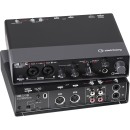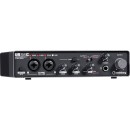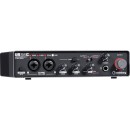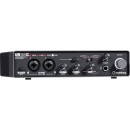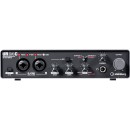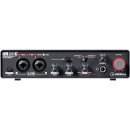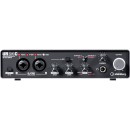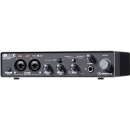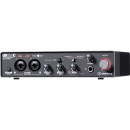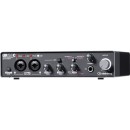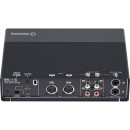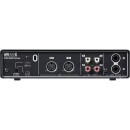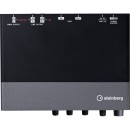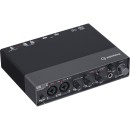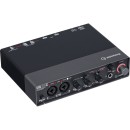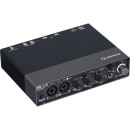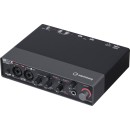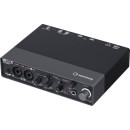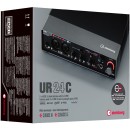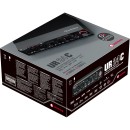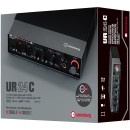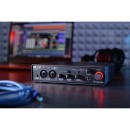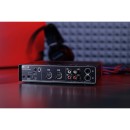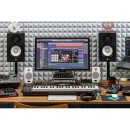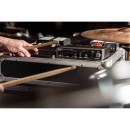Steinberg UR24C Audio Interface Review
- 24-bit/192 kHz audio resolution for professional sound quality.
- USB 3.0 connectivity for fast and reliable data transfer.
- Two Class-A D-PRE microphone preamps for pristine audio capture.
- Switchable monitoring modes with separate DJ and studio configurations.
- Loopback function for streaming and podcasting applications.
- MIDI input and output for seamless integration with MIDI gear.
- DSP effects, including REV-X reverb and Channel Strip, for zero-latency monitoring.
- Compatible with major DAWs and includes Cubase AI and Cubasis LE software.
- Sturdy metal chassis for durability and portability.
- Powerful headphone output for detailed monitoring.
Specifications, Advantages, and Disadvantages of the Steinberg UR24C
The Steinberg UR24C Audio Interface is a versatile and powerful tool designed for musicians, producers, and audio engineers seeking high-quality sound recording and playback capabilities. Equipped with two D-PRE microphone preamps, the UR24C ensures pristine audio capture, making it ideal for both studio and live settings. Its compact and rugged design is perfect for mobile recording and easy integration into any recording setup.
This audio interface boasts a USB 3.0 connection, ensuring fast and reliable data transfer, which is crucial for high-resolution audio work. The UR24C supports up to 32-bit/192 kHz audio resolution, offering professional-grade sound quality. Additionally, it features MIDI input and output, making it a flexible option for those needing to integrate with other MIDI devices.
The UR24C also includes the Loopback function, which is particularly useful for podcasters and live streamers, allowing for seamless integration of playback and live audio inputs. Furthermore, it comes bundled with Cubase AI and dspMixFx software, providing users with a comprehensive set of tools for music production and audio processing. Overall, the Steinberg UR24C Audio Interface is an excellent choice for anyone in need of a reliable, high-performance audio interface.
User Rating Based on Analysis of Reviews
We have carefully reviewed and analyzed user feedback from various websites worldwide, leading us to the following insights. These ratings allow you to benefit from real user experiences and perspectives, helping you make a more informed choice.
Purchase Value
85% of users were satisfied with the purchase value of the Steinberg UR24C, citing its competitive pricing for the features offered. Users appreciated the high-quality preamps, robust build, and versatile connectivity options that made it a worthwhile investment for both home studios and professional setups.
15% of users expressed dissatisfaction, feeling that the purchase value did not meet their expectations due to perceived limitations in functionality compared to more expensive models, or they encountered issues that required additional spending on accessories or replacements.
Quality of Materials
90% of users praised the quality of materials used in the Steinberg UR24C, noting its sturdy metal casing and durable knobs that provided confidence in its longevity. Many highlighted the interface's ability to withstand heavy use without showing signs of wear, making it ideal for frequent studio sessions.
10% of users were dissatisfied, reporting concerns about the durability of certain components like the input jacks or USB connection, which they felt could be prone to looseness or failure after extensive use.
Sound Quality
92% of users were satisfied with the sound quality, praising the clean, transparent audio capture and playback. The interface's high-resolution 32-bit/192 kHz audio quality was frequently mentioned as a highlight, providing crisp, detailed sound suitable for both recording and monitoring.
8% of users expressed dissatisfaction with the sound quality, noting occasional noise issues or interference that affected recordings. Some users felt the sound lacked warmth or character compared to higher-end models.
Ease of Use
88% of users found the Steinberg UR24C easy to use, appreciating the straightforward setup process and intuitive control layout. The compatibility with multiple DAWs and operating systems was also a positive point, allowing users to integrate it seamlessly into their existing setups.
12% of users faced challenges with ease of use, citing difficulties in driver installation or setup. Some users mentioned that the interface's software could be more user-friendly or intuitive, particularly for beginners.
Portability
80% of users were satisfied with the portability of the Steinberg UR24C, valuing its compact design and lightweight build that made it easy to transport between locations. This feature was especially appreciated by musicians who travel frequently for gigs or recording sessions.
20% of users found the portability lacking, mainly due to the reliance on external power sources or the need for additional components that made it less convenient to transport than anticipated.
Connectivity Options
86% of users appreciated the connectivity options available with the Steinberg UR24C, such as multiple input/output ports, MIDI capability, and USB-C connectivity, which provided flexibility for various recording and monitoring scenarios.
14% of users were dissatisfied with the connectivity options, feeling that the number of inputs/outputs was insufficient for larger setups or that certain connections were not as accessible as they would have liked.
Driver Stability
82% of users reported satisfaction with the driver stability, noting that the interface maintained a stable connection with minimal latency issues across different operating systems and DAWs. This reliability was crucial for uninterrupted recording sessions.
18% of users experienced dissatisfaction due to driver stability issues, reporting instances of crashes or connectivity drops that disrupted their workflow and required troubleshooting or technical support.
Software Integration
84% of users were pleased with the software integration, especially its seamless compatibility with Steinberg's Cubase and other popular DAWs, which enhanced their recording and production capabilities.
16% of users expressed dissatisfaction with software integration, mentioning occasional compatibility issues with certain DAWs or operating systems, and a learning curve associated with the bundled software.
Latency
87% of users were satisfied with the low latency performance of the Steinberg UR24C, which allowed for real-time monitoring and recording without noticeable delays, crucial for professional audio work.
13% of users faced dissatisfaction with latency, reporting occasional lag during playback or recording, which they found disruptive and hindered their ability to perform or produce effectively.
Preamp Quality
91% of users praised the quality of the preamps in the Steinberg UR24C, highlighting their clarity, low noise levels, and ability to handle a wide range of microphones effectively, making it suitable for various recording applications.
9% of users were dissatisfied with the preamp quality, feeling that it did not meet their expectations in terms of warmth or character, especially when compared to higher-end preamps.
Customer Support
78% of users were satisfied with the customer support provided by Steinberg, noting prompt responses and helpful assistance with technical issues or product inquiries, which enhanced their overall experience.
22% of users expressed dissatisfaction with customer support, citing slow response times or lack of resolution to their problems, which affected their perception of the brand's commitment to customer satisfaction.
Build Quality
89% of users were impressed with the build quality of the Steinberg UR24C, praising its solid construction and premium feel that conveyed reliability and longevity, important for professional use.
11% of users found the build quality lacking, mentioning specific issues such as loose components or cosmetic defects that raised concerns about the product's durability over time.
Compatibility with DAWs
85% of users were satisfied with the Steinberg UR24C's compatibility with various DAWs, which allowed for smooth integration and enhanced their recording and production workflow.
15% of users experienced compatibility issues with specific DAWs, which required workarounds or adjustments that they found inconvenient and time-consuming.
Input/Output Flexibility
83% of users appreciated the input/output flexibility of the Steinberg UR24C, which catered to diverse recording needs and provided ample connectivity for both simple and complex setups.
17% of users felt the input/output flexibility was insufficient for their requirements, particularly those with larger or more advanced recording setups that demanded more connectivity options.
Aesthetic Design
88% of users enjoyed the aesthetic design of the Steinberg UR24C, noting its sleek, modern appearance that complemented their studio or home setup and conveyed a sense of professionalism.
12% of users were not satisfied with the design, feeling that the aesthetic was too simplistic or did not match their personal style preferences, which affected their overall satisfaction with the product.
Power Supply
79% of users were content with the power supply options for the Steinberg UR24C, appreciating the USB-C power delivery that enabled flexible operation without the need for a dedicated power source.
21% of users expressed dissatisfaction, citing the reliance on USB power as a limitation for certain setups or situations where more robust power options would be beneficial.
Durability
84% of users found the Steinberg UR24C to be durable, withstanding regular use and transportation without significant issues, which contributed to their confidence in the product's longevity.
16% of users were dissatisfied with the durability, mentioning specific concerns about wear and tear on moving parts or connections that affected their trust in the product's long-term performance.
Feature Set
86% of users were pleased with the feature set offered by the Steinberg UR24C, highlighting its comprehensive functionality that catered to a wide range of recording needs, from simple tasks to more complex projects.
14% of users felt that the feature set was lacking, particularly those looking for advanced features or capabilities that were not included, which limited their ability to fully utilize the interface for specific applications.
User Manual and Documentation
77% of users found the user manual and documentation helpful, providing clear instructions and guidance that facilitated setup and troubleshooting, which was particularly beneficial for beginners.
23% of users were dissatisfied with the documentation, citing it as insufficiently detailed or complex, making it difficult to resolve issues or fully understand the product's capabilities.
Overall Satisfaction
88% of users expressed overall satisfaction with the Steinberg UR24C, praising its combination of quality, performance, and value that met their expectations and fulfilled their recording and production needs effectively.
12% of users were not entirely satisfied overall, due to specific issues or unmet expectations in certain areas, which affected their perception of the product's overall value and suitability.
In the following sections, we will delve into the detailed specifications of the Steinberg UR24C Audio Interface, exploring its strengths and weaknesses to provide you with a well-rounded understanding of this product.
Pros:
- High-quality 32-bit/192 kHz audio resolution for professional sound.
- USB 3.0 connectivity ensures fast and reliable data transfer.
- Compatible with Mac, PC, and iOS devices for versatile use.
- Includes Cubase AI and Cubasis LE software for easy music production.
- Offers both DAW and DJ modes to suit different audio production needs.
- Robust build quality with a metal chassis for durability.
Cons:
- Limited number of input/output ports compared to higher-end models.
- Might require additional software installation for optimal use on iOS devices.
- Pricier than some other entry-level audio interfaces.
- Some users may find the interface's learning curve a bit steep for beginners.
General
| Channels of I/O | Analog: 2 Input / 4 Output |
|---|---|
| Maximum Sampling Rate | 192 kHz / 32-Bit |
| Number of Microphone Inputs | 2 Preamps |
The Channels of I/O specification details the input and output configurations of the Steinberg UR24C Audio Interface. With 2 analog inputs and 4 outputs, this interface is designed for versatility in audio production. The two inputs allow for the connection of microphones or instruments, while the four outputs can be used to send audio to monitors, headphones, or other devices, making it suitable for both recording and mixing environments.Show More
The Maximum Sampling Rate indicates the highest quality of audio that the interface can handle, which is 192 kHz at 32-bit in this case. This high sampling rate and bit depth provide exceptional audio fidelity, allowing for detailed and nuanced sound reproduction. It is especially beneficial for professional audio applications, where capturing every detail of the sound is crucial, such as in music production and sound design.
The Number of Microphone Inputs refers to the availability of preamps for connecting microphones. With two microphone preamps, users can easily connect and record multiple vocalists or instruments simultaneously. This feature is essential for home studios or small recording setups, as it allows for flexibility and creativity in capturing audio without the need for additional equipment.
Signal Processing
| Gain/Trim Range | Mic Inputs: +6 dB to +60 dB Hi-Z Inputs: +0.8 dB +54.8 dB Line Inputs: -10 dB to +44 dB |
|---|
Gain/Trim Range refers to the adjustable sensitivity levels for different types of audio inputs on the Steinberg UR24C Audio Interface. This feature allows users to control how much amplification is applied to the incoming audio signal, which is crucial for achieving optimal recording levels without distortion.Show More
For Mic Inputs, the gain range spans from +6 dB to +60 dB. This wide range enables the user to capture quiet vocal performances or acoustic instruments effectively, ensuring clarity and presence in the recording. The higher gain settings are particularly useful for low-output microphones, allowing them to produce a strong signal suitable for mixing.
In the case of Hi-Z Inputs, which are designed for high-impedance instruments like electric guitars, the gain range of +0.8 dB to +54.8 dB helps to optimize the input for different pickups and playing styles. This flexibility allows musicians to achieve the desired tone and volume without introducing unwanted noise or distortion.
Lastly, Line Inputs feature a gain range of -10 dB to +44 dB, which is perfect for connecting external devices such as synthesizers or mixers. This range allows for the adjustment of levels to match the output of these devices, ensuring that the audio signal remains clean and balanced during recording or playback.
Connectivity
| Analog Audio I/O | 2x Combo XLR-1/4" TRS Balanced/Unbalanced Mic/Line/Hi-Z Input 2x 1/4" TRS Balanced Monitor Output 2x Stereo RCA Coaxial Unbalanced Line Output 1x 1/4" TRS Unbalanced Headphone Output |
|---|---|
| Phantom Power | 48 V (Selectable on Individual Inputs) |
| Digital Audio I/O | |
| Host Connection | 1x USB-C |
| Host Connection Protocol | USB 3.0 / 3.1/3.2 Gen 1 |
| MIDI I/O | 1x DIN 5-Pin Input 1x DIN 5-Pin Output |
The Analog Audio I/O specifications detail the inputs and outputs available on the Steinberg UR24C Audio Interface. It features two combo XLR-1/4" TRS inputs that can accommodate balanced or unbalanced microphone, line, or Hi-Z signals, providing flexibility for various audio sources. Additionally, it has two balanced 1/4" TRS monitor outputs for connecting studio monitors, two stereo RCA coaxial outputs for consumer audio devices, and a 1/4" unbalanced headphone output for monitoring. This variety allows users to connect multiple devices and manage their audio routing effectively.Show More
The Phantom Power option provides 48 V power that can be selected for individual inputs, which is essential for powering condenser microphones. This feature is critical for users who work with professional-grade mics, ensuring they can achieve optimal sound quality without the need for external power sources. The individual selection also enhances versatility, allowing users to choose which microphones receive phantom power based on their specific needs.
The Digital Audio I/O section indicates the absence of digital audio connections on the UR24C, which means it operates solely in the analog domain. While some interfaces offer digital connections like ADAT or S/PDIF for expanded routing options, the UR24C focuses on delivering high-quality analog audio, making it ideal for users who prioritize simplicity and reliability.
The Host Connection utilizes a USB-C interface, compatible with USB 3.0, 3.1, and 3.2 Gen 1 protocols. This connection type ensures fast data transfer speeds and stable performance, which is particularly beneficial for recording and playback of high-resolution audio. The use of USB-C also provides modern compatibility with a wide range of devices, enhancing its usability for musicians and audio professionals.
Lastly, the MIDI I/O specification includes a standard DIN 5-Pin input and output, allowing users to connect MIDI devices such as keyboards, controllers, and synthesizers. This feature is crucial for those who incorporate MIDI into their workflows, enabling seamless integration between audio and MIDI equipment for a complete music production setup.
Performance
| Frequency Response | Mic Inputs: 20 Hz to 22 kHz 0/-0.3 dB Monitor Outputs: 20 Hz to 22 kHz 0/-0.2 dB Line Outputs: 20 Hz to 22 kHz +0/-0.2 dB |
|---|---|
| Maximum Input Level | Mic Inputs: +6 dBu (Balanced) Hi-Z Inputs: +9 dBV (Unbalanced) Line Inputs: +22 dBu (Balanced) |
| Maximum Output Level | Line/Monitor Outputs: +12 dBu (Balanced) |
| Headphone Output Power | 15 mW per Channel |
| Impedance | Mic Inputs: 6 Kilohms (Balanced) Hi-Z Inputs: 1 Megohms (Unbalanced) Line Inputs: 12 Kilohms (Balanced) Outputs: 150 Ohms (Balanced) Headphone Outputs: 40 Ohms (Unbalanced) |
| Dynamic Range | Inputs: 102 dBA Outputs: 106 dBA |
| THD+N | Mic Inputs: 0.0035% Outputs: 0.002% |
Frequency Response: This specification indicates the range of frequencies that the audio interface can accurately reproduce. For the Steinberg UR24C, the frequency response for mic, monitor, and line outputs spans from 20 Hz to 22 kHz, with minimal deviation from flat (0 dB). A wider frequency response allows for better audio fidelity, ensuring that both low and high frequencies are captured and played back effectively, which is crucial for high-quality recordings.Show More
Maximum Input Level: This feature highlights the highest level of signal the audio interface can handle without distortion. The UR24C supports varying maximum input levels across different input types: mic, Hi-Z, and line. Higher maximum input levels mean that the device can accommodate louder sounds without clipping, making it suitable for a range of recording situations, from quiet vocals to loud instruments.
Maximum Output Level: This specification reflects the peak output level that the interface can deliver to connected devices. For the UR24C, the line and monitor outputs have a maximum level of +12 dBu. A higher output level ensures that the audio signal remains strong and clear when sent to speakers or other audio equipment, which is essential for maintaining high-quality sound reproduction.
Headphone Output Power: This feature denotes the power available for driving connected headphones, specified as 15 mW per channel for the UR24C. Sufficient headphone output power is necessary for achieving a good listening volume without distortion, particularly important for monitoring during recording sessions.
Impedance: The impedance ratings for various inputs and outputs indicate how much resistance the audio interface presents to incoming and outgoing signals. For instance, mic inputs have a high impedance of 6 Kilohms, while Hi-Z inputs are even higher at 1 Megohm. Higher impedance inputs are beneficial for capturing signals from high-impedance sources, such as electric guitars, while lower impedance outputs, like 150 Ohms for the outputs, help ensure compatibility with most audio equipment.
Dynamic Range: This specification measures the difference between the smallest and largest signals the interface can handle without distortion, with the UR24C featuring a dynamic range of 102 dBA for inputs and 106 dBA for outputs. A higher dynamic range allows for more detailed audio capture, providing a clearer representation of both quiet and loud sounds, which is vital for achieving professional audio quality.
THD+N (Total Harmonic Distortion + Noise): This measurement indicates the level of distortion and noise present in the audio signals processed by the interface. The UR24C has low THD+N values of 0.0035% for mic inputs and 0.002% for outputs, which means that the audio remains clean and true to the source. Lower distortion levels contribute to more accurate sound reproduction, making them important for high-fidelity recordings.
Digital Audio
| Sample Rates | Up to 192 kHz |
|---|---|
| Bit Depths | Up to 32-Bit |
Sample Rates: The Steinberg UR24C audio interface supports sample rates of up to 192 kHz. Sample rate refers to the number of samples of audio carried per second, measured in Hertz (Hz). Higher sample rates allow for more accurate representation of audio frequencies, which results in better sound quality and clarity. This feature is particularly beneficial for professional recording and mixing, where capturing fine details in the audio is essential.Show More
Bit Depths: The UR24C offers bit depths of up to 32-Bit. Bit depth determines the number of bits used to represent each audio sample, impacting the dynamic range and overall audio quality. A higher bit depth allows for a greater range of volume levels and reduces the noise floor, making it ideal for capturing quiet sounds without distortion. This is advantageous in studio environments where precision and fidelity are crucial.
Compatibility
| OS Compatibility | Windows 7 Windows 8.1 Windows 10 macOS 10.12 or Later 10 or Later |
|---|---|
| Processor Requirement | Mac: 2 GHz Intel Core i3 PC: 2 GHz Intel Core i3 PC: 2 GHz AMD |
| RAM Requirements | 2 GB |
| Storage Requirements | 1200 MB |
| Minimum Display Resolution | 1280 x 800 |
| Internet Connection | Required for Registration, Software/Driver Download |
The OS Compatibility feature indicates the operating systems that the Steinberg UR24C Audio Interface can function with, specifically Windows 7, Windows 8.1, Windows 10, and macOS 10.12 or later. This compatibility ensures that users can effectively integrate the interface into their existing setups, whether using a PC or Mac. It's crucial to check this specification to avoid any potential issues when trying to install and run the device on unsupported operating systems.Show More
The Processor Requirement specifies the minimum processor specifications needed for optimal performance of the audio interface. For both Mac and PC users, a 2 GHz Intel Core i3 or a 2 GHz AMD processor is recommended. This requirement guarantees that the audio interface can efficiently handle audio processing tasks, minimizing latency and improving overall performance during recording and playback.
The RAM Requirements state that a minimum of 2 GB of RAM is necessary for the Steinberg UR24C to function properly. Adequate RAM is essential for multitasking and running audio software smoothly, allowing users to work on music projects without experiencing performance bottlenecks.
Regarding Storage Requirements, the device needs 1200 MB of available space for installation. This space is necessary for the software and drivers that accompany the audio interface, making it crucial for users to ensure they have sufficient storage before proceeding with installation.
The Minimum Display Resolution of 1280 x 800 indicates the lowest screen resolution at which the device's software can be effectively utilized. A higher resolution provides a better user interface experience, allowing for easier navigation and clearer visibility of controls and settings within the software.
Lastly, the Internet Connection requirement signifies that an internet connection is necessary for the initial registration of the device and for downloading any software or drivers. This ensures that users have access to the latest updates and features, which can enhance the functionality and performance of the audio interface.
Power
| Power Requirements | AC/DC Power Adapter (Not Included), USB Bus Power |
|---|
The Power Requirements for the Steinberg UR24C Audio Interface indicate the types of power sources that can be used to operate the device. This specification mentions that the interface can be powered by an AC/DC power adapter, which is not included in the package, or via USB bus power. This flexibility allows users to choose the most convenient power source depending on their setup and usage needs, whether in a stationary studio environment or while on the go.Show More
Using an AC/DC power adapter typically provides a more stable power supply, which can be beneficial for extended recording sessions or when utilizing multiple channels at once. On the other hand, USB bus power offers the advantage of portability, as it eliminates the need for an external power source, making the UR24C an ideal choice for mobile recording setups. Users can easily connect the interface to a laptop and power it directly through the USB connection, enhancing convenience and usability in various scenarios.
Physical
| Operating Temperature | 32 to 72°F / 0 to 40°C |
|---|---|
| Dimensions | 7.8 x 6.26 x 1.85" / 19.8 x 15.9 x 4.7 cm |
| Weight | 2.4 lb / 1.1 kg |
Operating Temperature: The operating temperature range of 32 to 72°F (0 to 40°C) indicates the ideal environmental conditions for the Steinberg UR24C Audio Interface. This specification is important because it ensures that the device functions optimally without overheating or experiencing performance issues due to extreme temperatures. Maintaining the interface within this temperature range helps to preserve its longevity and reliability during use.Show More
Dimensions: With dimensions of 7.8 x 6.26 x 1.85 inches (19.8 x 15.9 x 4.7 cm), the size of the UR24C is compact enough for easy transport and integration into various studio setups. These dimensions allow for efficient space management, making it suitable for use in both home studios and professional environments. A smaller footprint can be particularly beneficial for users with limited desk space or for mobile recording applications.
Weight: Weighing in at 2.4 lb (1.1 kg), the weight of the UR24C is a factor that contributes to its portability. A lightweight design makes it easier for musicians and audio engineers to carry the interface to different locations, whether for live performances or remote recordings. This feature is particularly advantageous for those who value convenience without compromising on performance.
Packaging Info
| Package Weight | 3.55 lb |
|---|---|
| Box Dimensions (LxWxH) | 10.8 x 8.1 x 4.2" |
Package Weight: The weight of the Steinberg UR24C audio interface is 3.55 pounds. This measurement is important as it indicates the portability of the device. A weight of this nature suggests that the interface is relatively lightweight, making it easier for users to transport it for gigs, studio sessions, or personal use. A manageable weight is crucial for musicians and audio professionals who often travel with their equipment.Show More
Box Dimensions (LxWxH): The dimensions of the box are 10.8 x 8.1 x 4.2 inches. These measurements provide insight into the size of the product packaging, which is important for storage and transportation. A compact size allows for easier handling and fitting into various spaces, whether in a studio setup or when packed for travel. Additionally, knowing the box dimensions can help users plan for the space they need when receiving or storing the product.
Customer Images
Customer Questions
How do I install the Steinberg UR24C Audio Interface drivers on my computer?
To install the Steinberg UR24C drivers, visit the Steinberg website and download the latest version of the Yamaha Steinberg USB Driver. Once downloaded, run the installer and follow the on-screen instructions to complete the installation. Restart your computer if prompted.
Why is my Steinberg UR24C not being recognized by my computer?
Ensure that the USB cable is securely connected to both the UR24C and your computer. Try using a different USB port or cable if possible. Check the UR24C power supply if it's externally powered. Install the latest drivers from the Steinberg website and restart your computer.
How can I reduce latency when using the Steinberg UR24C?
To reduce latency, adjust the buffer size in your DAW or the Yamaha Steinberg USB Driver control panel to a lower setting. Keep your software and drivers updated, and close unnecessary background applications to free up system resources.
What is the proper way to set up the UR24C for recording in a DAW?
Connect the UR24C to your computer and install the necessary drivers. Open your DAW and select the UR24C as the input and output device in the audio settings. Configure your tracks to use the correct inputs for recording, and adjust the gain knobs on the UR24C to avoid clipping.
Why is there no sound coming from my headphones when using the UR24C?
Check that your headphones are properly connected to the headphone output. Ensure that the headphone volume knob is turned up and not muted. In your DAW, make sure the UR24C is selected as the output device and that the correct output channels are assigned.
How can I resolve audio dropouts and glitches with the UR24C?
Ensure that the USB cable is firmly connected, and try using a different port or cable. Reduce the buffer size and sample rate in your DAW settings. Close unnecessary applications to free up system resources, and make sure your drivers and DAW software are up to date.
What should I do if the UR24C's input signals are too weak?
Make sure the input gain knobs on the UR24C are adjusted to an appropriate level for your source. Use the Hi-Z switch when recording instruments with high impedance, such as electric guitars. Verify that your microphones or instruments are functioning correctly.
Can I use the UR24C with an iPad or iPhone?
Yes, the UR24C is compatible with iOS devices. You will need a USB-C to Lightning adapter or cable to connect it. Ensure that the UR24C is in CC mode by pressing the CC MODE button on the rear panel. In some cases, external power may be required.
How do I update the firmware on my Steinberg UR24C?
Download the latest firmware update from the Steinberg website. Connect your UR24C to your computer, and run the firmware updater tool. Follow the on-screen instructions to complete the update process. Do not disconnect the device during the update.
Why is there feedback or noise when using the UR24C?
Ensure that your cables are in good condition and properly connected. Check for ground loops or interference from other electronic devices. Adjust the input gain and monitor levels to avoid feedback. Use balanced cables where possible and ensure good cable management.
